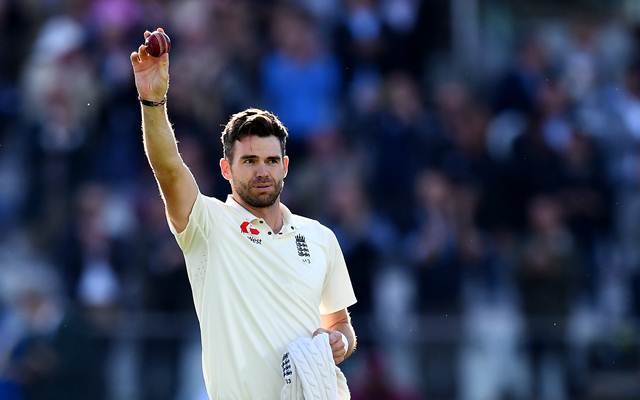James Anderson and that illusion called time
With every passing year, James Anderson has added new weapons to his bowling arsenal.
6 Min Read


It has almost been two decades since he first wore the England whites, but he still has the enthusiasm and passion burning inside him. He just celebrated his 39th birthday a couple of days back, but he still runs in with all his heart, match after match, year after year.
How can James Anderson still have ‘what it takes’ to succeed at the highest level? How does he still push himself even at the age of 39? Anderson is the only bowler in history to have played over 150 Test matches. He is the only fast bowler in history to have taken over 600 Test wickets.
It seems as if Father Time has still not been able to impose its will on Anderson. It seems as if time has been reduced to an illusion, and encroaching age cannot tame Anderson. With every passing year, Anderson has added new weapons to his arsenal, with every match he has played, he has found a way to reinvent himself.
James Anderson: Ageing like fine wine

James Anderson has aged like fine wine, and this is something that even some of the all-time greats of the sport have not been able to accomplish. Let us look at some numbers to understand how Anderson has got better with age. In the table below, let us compare Anderson’s overall record in Test cricket and his record in Tests after he turned 30.
| Matches | Innings | Wickets | Average | Strike Rate | 5W | Innings per five-wicket haul | |
| James Anderson’s overall Test career | 162 | 301 | 617 | 26.67 | 56.3 | 30 | 10.03 |
| James Anderson after the age of 30 | 91 | 170 | 349 | 23.82 | 55.1 | 18 | 9.44 |
James Anderson has played a whopping 91 Test matches after the age of 30, which in itself is a Herculean feat to accomplish. Also, as compared to his overall numbers in Tests, Anderson’s numbers after the age of 30 are even better. While Anderson averages 26.67 in Test cricket, the average comes down to just 23.82 after the age of 30. Also, his strike rate after the age of 30 is only 55.10, whereas his career strike rate is 56.30.
That is not all. Anderson has taken 30 five-wicket hauls in 301 innings, which means that he scalps a five-wicket haul in Test cricket once every 10.03 innings. And, after the age of 30, Anderson has taken 18 five-wicket hauls in 170 innings, which translates to a five-wicket haul taken once every 9.44 innings. The numbers prove that Anderson has performed exceedingly well after the age of 30 with the red cherry in hand.
James Anderson versus the rest: How have the all-time fast bowling greats fared after the age of 30?

Now, let us pit James Anderson against the five fast bowlers with the most wickets in Test cricket history. Let us dive deep into the numbers generated by these fast bowling behemoths after they had turned 30. The five fast bowlers with the most number of Test wickets are James Anderson (617 wickets), Glenn McGrath (563 wickets), Stuart Broad (523 wickets), Courtney Walsh (519 wickets), and Dale Steyn (439 wickets). In the table below, let us analyze the numbers of each of these behemoths after they turned 30.
| Player Name | Matches | Innings | Wickets | Average | Strike Rate | 5W | Innings per five-wicket haul |
| James Anderson | 91 | 170 | 349 | 23.82 | 55.10 | 18 | 9.44 |
| Glenn McGrath | 65 | 129 | 287 | 20.89 | 52.50 | 12 | 10.75 |
| Stuart Broad | 54 | 100 | 178 | 26.19 | 57.60 | 3 | 33.33 |
| Courtney Walsh | 81 | 147 | 341 | 24.17 | 58.30 | 17 | 8.65 |
| Dale Steyn | 28 | 49 | 107 | 23.86 | 46.10 | 5 | 9.80 |
Among these five bowling legends, James Anderson has scalped the highest number of wickets in the whites after the age of 30. Anderson’s average after the age of 30 is also better than Stuart Broad, Courtney Walsh, and Dale Steyn as well. Anderson has taken the most number of five-wicket hauls after the age of 30 as well.
That is not all. Anderson has a better Innings per five-wicket haul ratio after the age of 30 than the likes of McGrath, Broad, and Steyn. Surely, Anderson’s longevity and his consistency is praiseworthy.
James Anderson versus the rest after the age of 30 in a win in Tests

We are not done with the comparison yet. Now, let us go ahead and compare the numbers generated by these legendary bowlers after the age of 30 in a win in Test cricket in the table below.
| Player Name | Matches | Innings | Wickets | Average | Strike Rate | 5W | Innings per five-wicket haul |
| James Anderson | 37 | 74 | 170 | 16.43 | 40.90 | 12 | 6.17 |
| Glenn McGrath | 50 | 100 | 237 | 18.39 | 48.10 | 10 | 10 |
| Stuart Broad | 25 | 50 | 92 | 20.00 | 45.80 | 1 | 50 |
| Courtney Walsh | 26 | 52 | 137 | 18.27 | 43.90 | 7 | 7.43 |
| Dale Steyn | 13 | 24 | 71 | 18.52 | 36.80 | 5 | 4.80 |
This table underlines the greatness of James Anderson. Among the five bowling legends, Anderson averages the best in a Test win (16.43) after the age of 30. Even though Dale Steyn might have a better strike rate than Anderson, the fact that the England pace bowling legend has taken 99 wickets more than Steyn and has featured in almost three times the number of Test wins after the age of 30 than Steyn tilts the scale in Anderson’s favour.
Also, Anderson has taken the most number of five-wicket hauls among these five titans after the age of 30 in a Test win as well. Anderson also has the second-best innings per five-wicket haul ratio among the five bowlers in a win after 30 as well. Anderson’s numbers in a Test win after the age of 30 are splendid.
In Conclusion

In two days’ time, James Anderson will once again run in at full throttle against Virat Kohli and his men in a five-match Test series. He will make the ball move both ways and will pose a lot of uncomfortable questions to the Indian batsmen. But most importantly, he will once again delude us into believing that the passage of time does not affect him.
Note: All the stats have been taken from Cricinfo and have been updated as on 2nd August 2021.
Download Our App